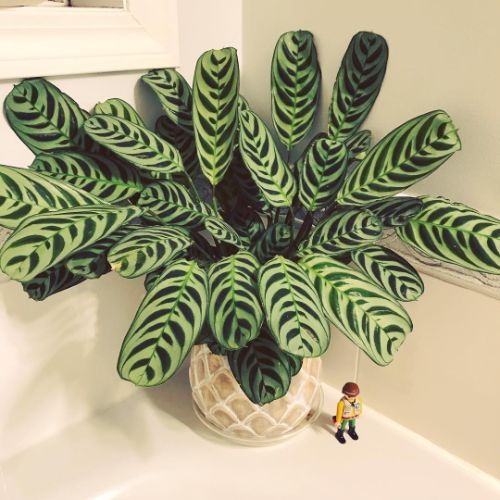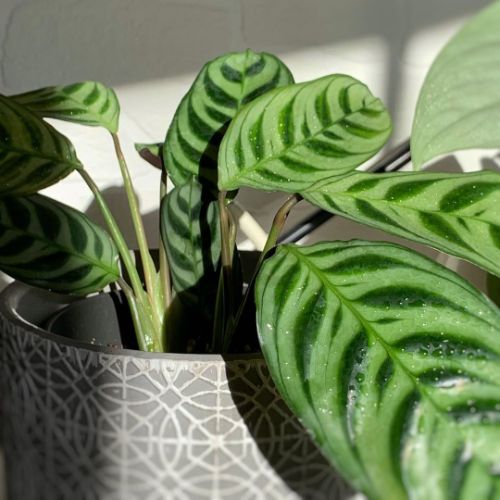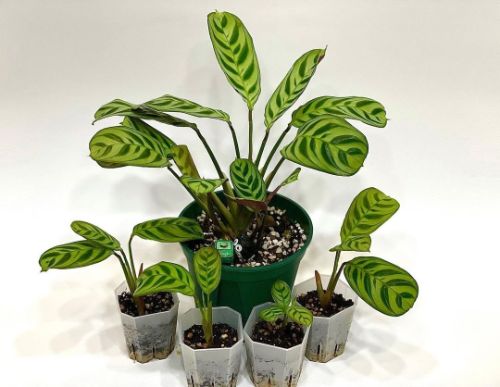Check out this cool plant, the Burle Marx Calathea! It’s got awesome silvery-green leaves with this funky purple pattern underneath. No wonder everyone’s picking it up for their homes. But you know what? It’s not just about the good looks. If you take a closer look, you’ll see why it’s a winner for indoor gardening.
This little beauty is not just a pretty face, it also helps to clean the air and it’s not too much of a fuss to take care of. So, if you’re thinking about adding it to your indoor plant family, keep reading. We’ll chat about how to care for it, the different types you can find, how to show it off, and more.
About Burle Marx Calathea
This plant’s actually named after this plant-loving guy, Sr. Roberto Burle Marx, and it originally comes from Brazil. It belongs to the Marantaceae family, which is also called the Prayer Plant Family, because it has this cool trick where it can fold up its leaves at night.
But the real showstopper is the leaves. They have these dark green stripes and a fishbone pattern on a grey-green background. Often, the Burle-Marxii leaves can have a red or grey flipside. These leaves can grow up to a foot long and they’re grouped together like fans.
This plant is all about the humidity – makes sense since it’s from South America, right? If you want to plant it outside, you’ll have better luck in the USDA hardiness zones 10 to 12.
Oh, and you might spot some flowers on it, but they’re not really the main event. They grow in clusters at the end of long stalks that poke through the leaves. They usually bloom in winter or early spring, and they’re not scented. The flowers are tiny, white, and produce red bracts.

Calathea Burle Marx care overview
| Scientific Name | Ctenanthe burle-marxii |
| Common Name | fishbone prayer plant, blue ice plant |
| Origin | Brazil |
| Mature Size | Mature height: 20 inches; Mature width: 10 to 16 inches |
| Soil Type | moist, fertile soil with good drainage |
| Soil pH | between 5.6 and 6.5 |
| Bloom Time | winter or early spring |
| Light Requirements | bright, indirect sunlight. |
| Watering | Likes to stay moist |
| Temperature | 65°F to 75°F (18°C to 24°C) |
| Fertilizer | Feed it once a month during spring and summer. |
| Humidity | at least 60% humidity |
| Pruning | Get rid of the dead leaves and keep the others dust-free |
| Propagation | division or stem cuttings. |
| Re-Potting | Do this every 1-2 years |
| Toxicity | Safe, it’s not toxic |
Caring for a Burle Marx Calathea
Light Requirements
Look, the Burle Marx Calathea is a total knockout with its unique leaf patterns, but it’s a bit of a diva when it comes to lighting. It digs bright, indirect sunlight. Direct light is a no-no – it’s like a sunburn to its delicate leaves. If you notice its leaves curling up, your plant might be throwing a bit of shade for not getting enough light.
You can park it by an east- or north-facing window, where it can lap up filtered light all day.
If your place doesn’t get a lot of natural sunlight, don’t worry! Just get a fluorescent bulb or grow light to give your Calathea its daily dose of light.
Remember, it’s all about balance. Too much light can also hurt your plant, so make sure you’re getting it just right.
Discover how to meet your Calathea’s light needs for thriving foliage. Explore Calathea Light Requirements now!

Soil
When it comes to soil, this Calathea digs a mix of three parts peat, one part perlite, and one part sand. Peat keeps the soil moist while sand and perlite help with draining. The soil should feel a bit damp but never sopping wet.
Here’s what to look for in your soil mix:
- Peat: It’s a moisture magnet.
- Perlite: Helps with draining.
- Coco coir: This can soak up a lot of water.
- Sand, coconut husks, or orchid bark: These give your soil good drainage.
A good mix would be two-thirds peat and one-third perlite. This mix will keep the water right where your plant needs it while draining the excess.
Unlock the secret to vibrant Calathea growth with the Best Soil for Calathea. Learn more now!
Watering
When it comes to watering, your Burle Marx likes it best when it’s in tune with the seasons.
In the summer and spring, water it about once every week or so. Just make sure the soil is moist but not soaking.
In the winter, cut back to watering it every two weeks or so. You just want to keep the soil a little moist, not drenched.
Overwatering can cause root rot and other nasty issues, so try to find a balance that makes your plant happy.
After watering, let the soil dry out before you water it again. This helps you avoid overwatering and keeps your Calathea looking fab.
Watering your Calathea correctly is key to keeping this beautiful prayer plant healthy and looking its best.

Temperature
For your Burle Marx Calathea to really thrive, try to keep the temperatures between 18°C to 24°C (65°F to 75°F).
Temperatures outside this range can stress your plant out and slow its growth.
To avoid shocking your plant, never use super cold or hot water when you water it.
Steer clear of places near doors or air conditioners. Even a bit of cold can mess with your Calathea’s health.
Humidity
Humidity is a big deal for your Burle Marx Calathea – never let it drop below 60%. You can up the humidity by:
- Spraying the leaves now and then
- Putting a humidifier in the room
- Bunching plants together
- Moving your plant somewhere damp – like the kitchen or bathroom.
With the right humidity, your Calathea will have lush, vibrant foliage. Keep a close watch on humidity levels, because if they drop, you could end up with crispy leaf tips.
Another plus of high humidity? It helps keep spider mites away. So, make sure your place isn’t too dry if you want to keep these pests out.

Fertilizer
Fertilizer is a must-have if you want a thriving Burle Marx Calathea. Fertilize at least once a month during spring and summer with a balanced or slow-release fertilizer.
In the fall and winter, you can cut back to every other month. Fertilizers with a lot of nitrogen will help your plant’s leaves stay green and lush.
Make sure you follow the directions on the package for how much and how often to fertilize to give your Calathea the right amount of nutrients.
Look for fertilizers with these important nutrients: Potassium; Phosphorous \ nitrogen, Calcium , and magnesium.
You can add fertilizer as a liquid, granules, or as a top dressing. Just be careful not to overdo it – too much can harm your plant’s roots.
Repotting
Repotting your Burle Marx Calathea is a big part of keeping your plant happy and healthy. It can stimulate growth and help prevent root rot as the soil gets old and compacted.
Repotting also gives you a chance to check the roots of your Calathea and make sure they’re healthy. Try to repot your Burle Marx Calathea every 1-2 years, preferably in the spring.
Here’s how to repot your Calatheas:
- Take them out of their current pot – be careful with the root ball.
- Find a pot one size up from the current one.
- Put the root balls in the new pots and add soil as needed.
- Give your plants a drink to help settle the soil.
- Watch for any signs of stress as your plant gets used to its new digs.
Discover the perfect timing for repotting your Calathea. Read more about When To Repot Calathea now!

Pruning
Pruning your Burle Marx Calathea helps keep it healthy and looking its best. Here’s some tips on how to prune your plant:
- Got yellow or brown leaves: They’re probably dying or already dead. Snip them off at the stem base with clean, sharp scissors or pruning shears.
- Got leggy stems: Trim them back to encourage bushier growth. Cut back the stem to a healthy node, where the leaves meet the stem.
- Control plant size: Prune back the outermost leaves to control its size. This will encourage new growth.
- Notice any damaged or sickly looking leaves: Snip them off to prevent any disease from spreading.
Always use clean, sharp tools when pruning your Calathea to prevent damaging the plant. Also, avoid pruning more than a third of the plant at once – it can stress out the plant and affect its growth.
Related: Calathea Triostar Care: The Complete And Best Guide
Burle Marx Calathea Propagation
Making more Burle Marx Calatheas isn’t that hard and can be done by dividing the plant or taking stem cuttings.
- Propagation by division means you chop up the root clump of the Calathea into two or more pieces, making sure each piece has at least one leaf and some roots. Then pop these divisions into individual pots filled with moist potting mix.
- Propagation by stem cuttings means you take healthy stems from the plant that have at least two leaves and no signs of disease or pests. Dip the stems in rooting hormone and then stick them in pots filled with moist potting mix and lightly cover them with moss or vermiculite.
Both methods should be done in a warm and humid environment to encourage roots to grow. Once the roots have started to develop, keep the new plants moist and let them get used to their new environment before moving them to a more permanent spot. Make sure you plant them somewhere with bright indirect light. With the right care and attention, you can get healthy new Calatheas from propagation.
Propagating Burle Marx Calatheas is an easy process, but it does need a bit of patience and dedication. With the right conditions and care, you can successfully make more of these beautiful plants by division or stem cuttings. Propagation is a great way to get more of these colorful plants to brighten up your home.

Burle Marx Calathea Common Pests & Plant Diseases
Common Pests
Like other houseplants, Burle Marx Calatheas can be hit by bug infestations that can damage their leaves and slow down their growth. Here are some common bugs that can mess with your Calathea:
- Spider mites: These tiny pests can spin webs on the leaves and cause brown or yellow spots on the foliage. Spider mites like dry conditions, so it’s super important to keep the area around the plant humid.
- Mealybugs: Mealybugs are white, cottony bugs that can stick to the leaves and stems of the plant, sucking out its sap and gradually weakening it. You can get rid of them by spraying the plant with insecticidal soap or wiping the leaves with a cotton swab dipped in rubbing alcohol.
- Scale insects: These hard, brown or black bugs can stick to the leaves and stems, sucking out the plant’s sap and weakening it over time. Get rid of them by spraying the plant with insecticidal soap or with a cotton swab dipped in rubbing alcohol.
- Fungus gnats: These tiny, black bugs hang out near the soil of the plant, and their larvae can harm the roots. You can control fungus gnats by watering the plant less and using a soil mix that drains well.
To stop an infestation from spreading, make sure you check your Burle Marx Calathea regularly for any signs of bugs. You can also prevent bugs by keeping your plant’s environment clean and healthy and not watering too much.
Diseases
Burle Marx Calatheas can get hit by a few diseases, like leaves turning yellow or brown, droopy leaves, wimpy stems, and root rot.
Things that can make your Calathea sick include low humidity, too much light, salty soil, and fertilizer burns. If it gets too hot, your plant can get stressed and start to droop. Watering it wrong can make the leaves wilt or turn brown. Root rot happens when the soil gets too wet, which lets fungus grow and the roots start to rot.
Keep an eye on your plant and if you see changes like leaves turning yellow or brown, drooping leaves, or weak stems, you need to do something about it ASAP to stop the damage and save your Calathea.
The key to keeping your Calathea healthy is
- Taking care of it properly.
- Make sure you water it regularly, but not too much;
- The soil should be moist but not waterlogged.
- Put the plant somewhere it gets enough light, but not direct sunlight because that can burn the leaves.
- Keep the air humid so the leaves don’t wilt or turn brown, and fertilize it the way it says on the pack.
- Keep an eye on your Calathea for signs of stress or disease, and do something about it if you see anything.
FAQ about Burle Marx Calathea care
Q: What kind of light does a Burle Marx Calathea need?
A: This plant likes bright indirect light. If the light is too strong or direct, the leaves can start to fade and lose their patterns. A good rule of thumb is to keep your Calathea at least 3 feet away from any windows. Also, make sure you turn the plant regularly so all sides get equal light.
Q: How should I water my Calathea?
A: Water your Burle Marx Calathea when the top 2 inches of soil feel dry. The amount of water you need will depend on your specific situation, but in general, you should water the soil until it’s evenly moist. Also, make sure to rinse out any excess salt or mineral buildup from time to time by letting the water run through the pot. That way your Calathea will stay healthy and look good.
Q: What do calathea flowers look like?
A: Even though it doesn’t have fragrant blooms, it does make clusters that you can see at the end of a stalk that comes out of its dense foliage and a white flower.
Q: Why is my Calathea burle marx dying?
A: There are a few reasons including too much light, too cold, overwatering, and bugs and diseases. Any of these stresses or a mix of them could be the problem.
Q: Is Calathea burle marx toxic to pests?
A: No. It’s safe for your pets. You don’t have to worry about it causing harm because it doesn’t have any toxic compounds.
The Calathea Burle Marx is a beautiful ornamental masterpiece, with its rich red underleaf and striking fishbone pattern in dark green on light green leaves.
With the right care, your Burle Marx Calatheas will give you lots of stunning leaf displays over the years. Hopefully, this ultimate guide has everything you need to know about how to grow and care for one of these awesome plants! Don’t forget that Famiplants is here to help you with your plant parenting. So why wait? Start growing today!

